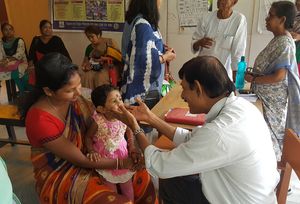Good governance is the bedrock of inclusive and equitable development. It is not progress if it does not percolate down to the grassroots or extend a helping hand to lift the last person up. It is about empowering people with the tools that will enable them to grow individually and as a community. This requires a capacious and humane public administration.
Since its launch five years ago, the aspirational districts programme (ADP) has transformed the lives of the people in 112 of the most under-developed districts of the country. According to an independent appraisal report released by the UNDP in 2021, districts that were previously neglected, located in remote regions and affected by leftwing extremism ‘experienced more growth and development in the last three years than ever before’. The report credited the programme as ‘immensely successful in propelling development among the [under-development] districts’.
The report also acknowledged the remarkable commitment shown by the topmost political leadership of the country. In fact, earlier last year, in an interaction with district magistrates across the country, Prime Minister Narendra Modi highlighted that the aspirational districts were eliminating the barriers to progress of the country and becoming an accelerator instead of an obstacle. He said the next step would be for them to go from aspirational to inspirational and start breaching global benchmarks of development.
It has been extremely satisfying to witness the ADP’s remarkable journey so far. Not only have all the 112 aspirational districts registered improvement in key socioeconomic outcomes, in some cases they have even out-performed non-aspirational districts in respective states. The programme has successfully managed to improve the quality of life of the people in these districts through its 3Cs approach—‘convergence’ (of Central and state schemes), ‘collaboration’ (between Central- and state-level officers and district collectors), and ‘competition’ among districts through a system of monthly delta ranking—fuelled by a mass movement.
The aspirational districts programme’s astute use of technology also proved to be a catalyst in producing the desired results. The ADP’s champions of change platform monitors in real-time the progress of the districts on the key performance indicators, which are grouped under five heads: health and nutrition, education, agriculture and water resources; financial inclusion and skill development, and basic infrastructure. Based on the improvements recorded from the baseline, the districts are ranked monthly, thereby stimulating competition between the districts to perform better.
Modi recently launched the aspirational blocks programme in 500 districts. This is the natural next step in the ADP journey—to focus on lagging blocks, as they form the core unit of development in Indian public administration. The aspirational blocks programme can prove to be a game-changer in spurring growth in the underdeveloped blocks of the country by replicating the ADP model. This could be achieved by empowering officials working on the ground who know the pulse of the masses and would involve improving the governance mechanisms at the level of block administration. The block is the touchpoint of services within the local community, and the most important node/unit for development planning and execution. The role of block-level officers must be duly recognised in this regard and they should be appropriately empowered to identify challenges, design suitable policy interventions and implement and monitor them.
The aspirational blocks programme must also leverage technology like the ADP to develop a robust data-monitoring and-evaluation system to identify critical gaps where policy intervention is needed to improve socio-economic outcomes, and instil a spirit of competition among the blocks, thereby incentivising them to course-correct and learn from each other’s best practices.
In its appraisal, the UNDP recommended replication of the ADP model, ‘a very successful model of local area development’, in other parts of the world ‘where regional disparities in development persist for many reasons’. The study found that the aspirational districts programme had acted as a catalyst for expediting development in these districts. By focusing on development that marries both economic growth and social progress, the aspirational districts programme has significantly improved the ease of living at the grassroots.
Author is G20 Sherpa and former CEO, NITI Aayog. Views expressed are personal.


